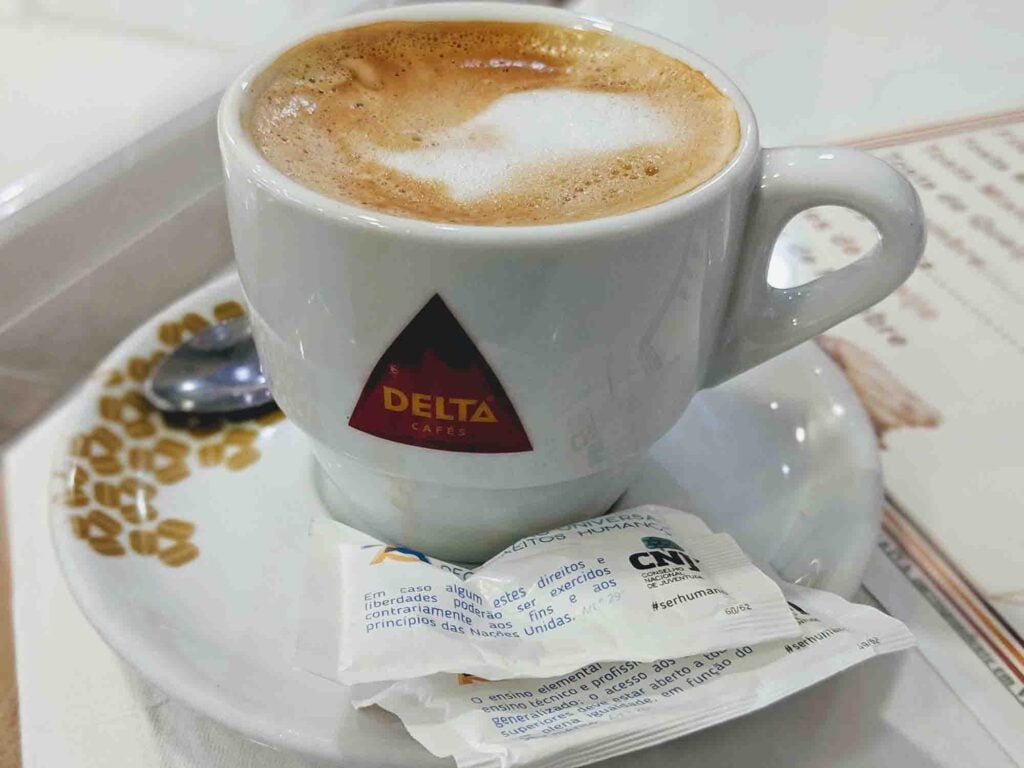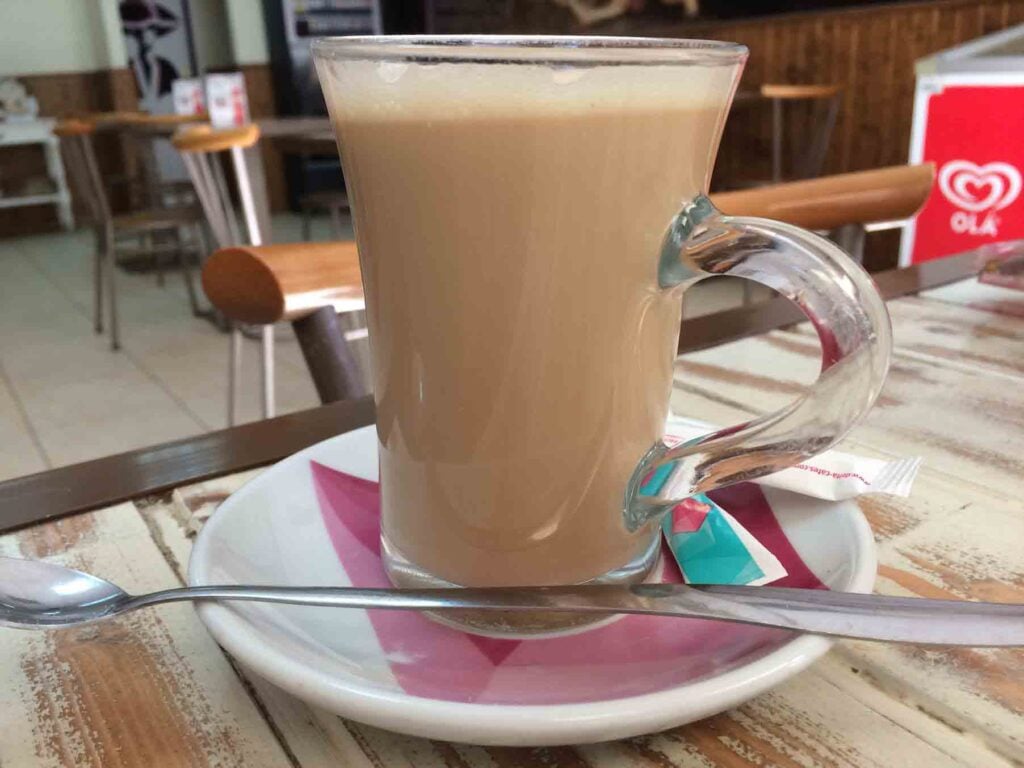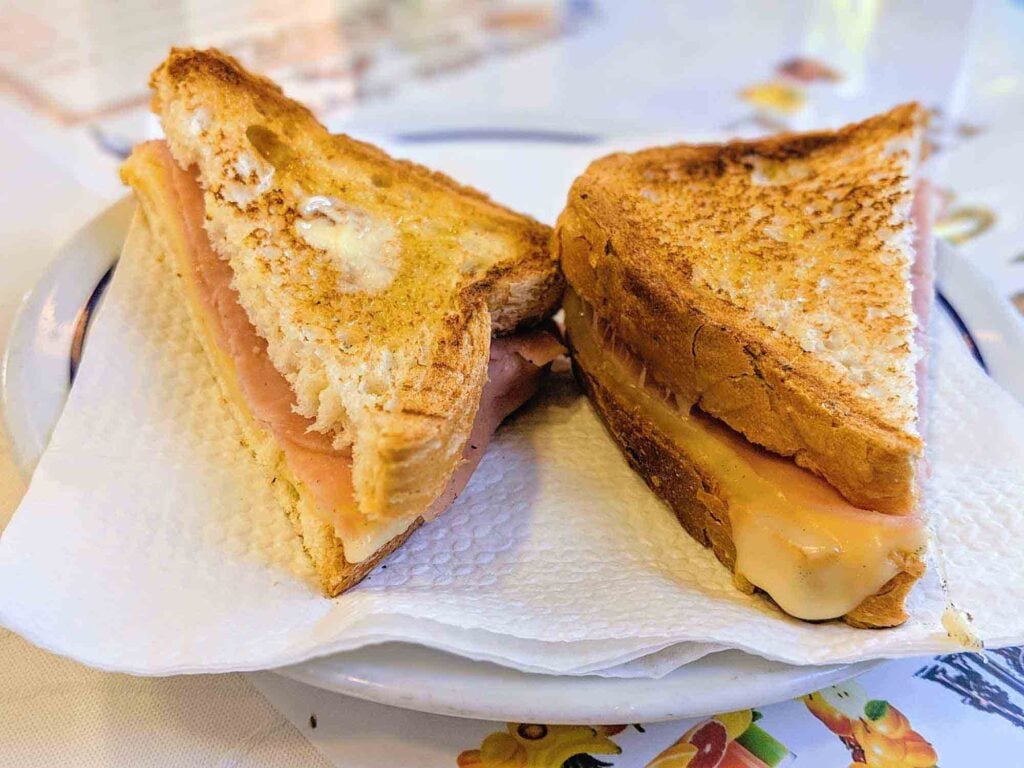While there’s no set “Portuguese Breakfast” like there is an “English Breakfast” or “German Breakfast,” there is a theme to what the Portuguese eat for breakfast.
And it’s not pastéis de nata, surprisingly. They might feature later in the morning at around 11 am for lanche da manhã – although it’s just as likely to be another Portuguese cake or pastry as a pastel de nata – but they’re rarely the first thing that the Portuguese eat.
However, if you’re visiting, don’t feel like you can’t have a delicious Portuguese cake or pastry with your coffee. Although most Portuguese people will be eating toast or a sandwich of some kind, there’s nothing to stop you ordering a pastel de nata or one of the many other delicious cakes that Portugal has to offer. As authentically Portuguese as toast is, it’s not as exciting as exploring the unique cakes, pastries, and other dishes Portuguese cuisine has to offer.
Alternatively, if you want something that’s half-way between sweet and savoury, try a Pão de deus, which is a bread topped with sweet desiccated coconut. You will be asked whether you want this plain. The other options are with butter, cheese, or ham and cheese.

Love Portuguese Pastries?
Why not learn to make pastéis de nata with this Lisbon-based cookery class?
What the Portuguese Traditionally Eat
The most common items you’ll find in a Portuguese breakfast are:
- Bread.
- Sliced cheese.
- Sliced ham.
- Jam
- A milky coffee.
Sometimes it’s just toast without the ham and cheese, but the common denominators are almost always bread and a milky coffee like a galão or a meia de leite.

The bread comes in different formats: it might be sliced, toasted, a bread roll, or maybe even a croissant. The ham and cheese are always the same: sliced “flamengo” cheese, which is Edam cheese, and sliced ham.

I’ve travelled all over Portugal, which varies considerably in terms of climate, geography, and culture and this is the most typical breakfast at a hotel or guesthouse. Usually, you can also get cereals such as muesli and diluted juice or squash as well.
What people eat at home is often slightly different: like everywhere else, many people have a rushed breakfast of just toast and coffee or maybe cereal in the morning.
Others, particularly the younger generations, will swap the bread, processed ham, and processed cheese for healthier items like muesli, fruit, eggs, etc.
What You Should Eat
If you want to be traditional, the most typical things you can order are
Coffee:

- A galão (GAL-OW-N)
- A meia de leite (MAY-A-DE-LAY-T)
- A café (espresso-sized coffee)
- An abatanado (larger, almost Americano-sized coffee, pronounced A-BAT-AN-AD-O)
While the espresso (um café) is the type of coffee that’s most commonly drunk in Portugal, in the morning, milky coffees are more common. The two most common types are a galão or a meia de leite.

Alternatively, you might see some people, usually men working in manual labour jobs, drinking beer in the morning or older men having a little shot of brandy in their coffee.
Bread:

- Toast – It’s quite common to go into a café in the morning and just order toast, usually with butter but it could be with jam or something else instead. This might seem a bit basic to outsiders, but those thick slices of bread are really very addictive.
- Sandwich – One way that Portugal differs from other countries is that people often have what most non-Portuguese people would class as a lunchtime sandwich for breakfast. This is a ham or sliced cheese sandwich, or both, and it usually comes in either a bread roll or a savoury Portuguese croissant. If it comes in sliced pan, it’s often toasted.
- Some common types include:
- Sande de queijo (cheese sandwich)
- Sande de fiambre (ham sandwich)
- Sande mista (ham and cheese sandwich)
- tosta mista (ham and cheese toastie)
- Some common types include:
- Toasted Sandwich

It’s quite common to put ham and cheese inside a sweet bread like Pão de Deus or in a Portuguese croissant. This combination of the sweet and the savoury might be a little unusual depending on where you come from, but it works and it’s worth trying.

If you want to be less traditional, opt for a cake of pastry.
Here are three that you could consider trying:
- Pastel de nata: Often dubbed as Portugal’s most iconic sweet treat, Pastel de nata is a creamy egg tart pastry. Its origin traces back to the Jerónimos Monastery in Lisbon. With a flaky crust, filled with a luscious custard, it’s often sprinkled with cinnamon and powdered sugar, making it a favourite not just in Portugal but worldwide.
- Bolos de Arroz: Translating to “rice cakes,” Bolos de Arroz are traditional Portuguese muffin-like cakes made predominantly from rice flour. They have a distinctive texture, a little denser than standard muffins, and are recognisable by their domed shape and often a sprinkle of sugar on top, giving them a delightful sweet crust. It’s a good option if you’re looking for something that’s not too sweet.
- Queijadas: A celebrated gem in Portuguese confectionery, Queijadas are small, round pastries renowned for their creamy and sweet fillings, predominantly made with cheese, hence the name which translates to “little cheesecakes”. While they can be found throughout Portugal, various regions boast their own special twists and unique ingredients. Among the most famous are the Queijadas de Évora, which hail from the Alentejo region, infusing the traditional recipe with a delightful taste of almond and cinnamon. Then there’s Queijadas de Sintra, which are deeply rooted in the history of the Sintra municipality, showcasing a rich cheese filling encased in a thin, crispy crust. Another variant, the Queijadas Dona Amélia, named in honour of Queen Amélia of Orleans and Bragança during her visit to the Azores, combines the flavours of cinnamon, raisin, and molasses, creating a distinctive taste.
FAQs
Do the Portuguese eat brunch?
While there are now a lot of brunch places – as in places with dishes like eggs benedict and pancakes – in Lisbon and Porto, brunch isn’t typically Portuguese (although these places are popular with younger Portuguese generations).
Where can I try an authentic Portuguese breakfast?
If you’re in Portugal, you won’t have to look very hard to find a traditional café or pastelaria. You’ll find one on every street in any Portuguese town or city.
Where can I find speciality coffee in Portugal?
There are plenty of hipster cafés in Lisbon, Porto, and also some towns on the Algarve that serve speciality coffees like flat whites, lattes, and chemex coffees but, outside of the big cities, it’s very unlikely that you’ll find these coffees.
Which cakes are eaten in the morning?
Breakfast (which takes place at around 8 am) usually focuses on bread of some kind rather than cakes. There’s nothing to stop you ordering any cake or pastry, of course, but it’s more typical to eat these at around 11 am.


